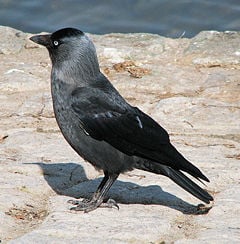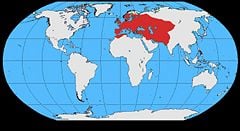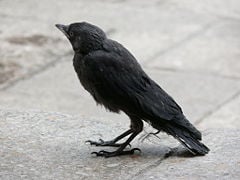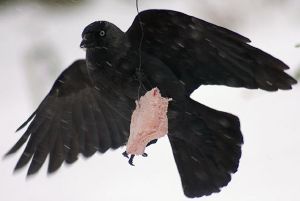Jackdaw
| Jackdaw | ||||||||||||||
|---|---|---|---|---|---|---|---|---|---|---|---|---|---|---|
 | ||||||||||||||
| Scientific classification | ||||||||||||||
| ||||||||||||||
| Corvus monedula (Linnaeus, 1758) | ||||||||||||||
 Jackdaw range
|
Jackdaw is the common name for a gregarious Eurasian bird, Corvus monedula, one of the smallest species in the genus of crows and ravens, characterized by black plumage, a gray nape, and distinctive gray-white iris. It is found across Europe, western Asia, and North Africa. It is sometimes known as the Eurasian jackdaw, European jackdaw, Western jackdaw, or formerly simply the daw.
The term jackdaw also is used for another member of the Corvus genus, the Daurian jackdaw (Corvus dauricus), which is found in Siberia, Mongolia, and China. It is quite similar in appearance and habits to C. monedula, but the Daurian jackdaw has a black iris, and many of the Daurian jackdaws have large areas of creamy white on the lower parts, extending up around the neck. This article, however, will be limited to discussion of C. monedula.
Like the crows and ravens, the jackdaw in some cultures is sometimes considered a bad omen, such as an omen of death. However, jackdaws provide important functions. Ecologically, they play a role in food chains, consuming animal and plant matter and being consumed by foxes, cats, birds of prey, and various egg predators. For humans, the highly intelligent jackdaws have often been a focus of interest. Among interesting behaviors of jackdaws is the fact that they practice food sharing, where donors offer food to a number of individuals, even regardless of kinship, and they share their preferred food more readily than less preferred food. Such sharing of food and objects is rare even in primates and jackdaws show a much higher level of active giving than documented for chimpanzees.
Overview and description
The Corvus genus in the Corvidae family incldues crows, ravens, rooks (one extant species, C. frugilegus), and jackdaws (two species, C. monedula and C. dauricus). These are large passerine birds that are characterized by strong feet and bills, feathered, rounded nostrils, strong tails and wings, rictal bristles, and a single molt each year (most passerines molt twice).
The jackdaw (C. monedula) is one of the smallest species in the Corvus genus, measuring 34 to 39 centimeters (13-15 inches) in length. Most of the plumage is black or grayish black except for the cheeks, nape, and neck, which are light gray to grayish silver. The iris of adults is grayish white or silvery white, the only member of the genus outside of the Australasian region to have this feature. The iris of juvenile jackdaws is light blue. Sexes and ages are alike (Porter et al. 1996; Mullarney et al. 1999).
In flight, jackdaws are separable from other corvids by their smaller size, faster and deeper wingbeats, and proportionately narrower and less fingered wings. They also have a shorter, thicker neck, a much shorter bill and frequently fly in tighter flocks. Underwing is uniformly gray, unlike choughs. On the ground, jackdaws strut about briskly and have an upright posture.
The Daurian jackdaw (C. dauricus) is about the same size or perhaps slightly smaller (32 centimeters in length), with the same proportions and identical habits. The principal difference is its plumage; many but not all adults of c. dauricus have large areas of creamy white on the lower parts, which extend up around the neck as a thick collar. The head, throat, wings, and tail are glossy black and the ear coverts are grizzled gray. Darker adults and young birds resemble Eurasian jackdaws, although Daurian jackdaws have a black iris, unlike the distinctive gray-white iris of the Eurasian jackdaw.
Distribution and habitat
Jackdaws (C. monedula) are resident over a large area stretching from North West Africa through virtually all of Europe, including the British Isles and southern Scandinavia, westwards through central Asia to the eastern Himalayas and Lake Baikal. They are resident throughout Turkey, the Caucasus, Iran, Iraq, Afghanistan, Pakistan, and north-west India.
The species has a large range, with an estimated global extent of between 1,000,000 and 10,000,000 km². It has a large global population, with an estimated 10 to 29 million individuals in Europe (BI 2008).
Jackdaws are mostly resident, but the northern and eastern populations are more migratory (Offereins). Their range expands northwards into Russia to Siberia during summer, and retracts in winter (Mullarney et al. 1999). They are winter vagrants to Lebanon, first recorded there in 1962 (Ramadan-Jaradi et al. 2008). In Syria, they are winter vagrants and rare residents with some confirmed breeding (Murdoch and Betton 2008). The soemmerringii race occurs in south-central Siberia and extreme northwest China and is accidental to Hokkaido, Japan (Brazil 2007).
A small number of jackdaws reached the northwest of North America in the 1980s, presumably ship-assisted, and have been found from Atlantic Canada to Pennsylvania (Dunn and Alderfer 2006). They have also occurred as vagrants in Canada, the Faroe Islands, Gibraltar, Iceland, Mauritania, and Saint Pierre and Miquelon. Jackdaws are regionally extinct in Malta and Tunisia (BI 2008).
Jackdaws inhabit wooded steppes, woodland, cultivated land, pasture, coastal cliffs, and villages and towns.
Behavior
Jackdaws are voluble birds. The call, frequently given in flight, is a metallic and somewhat squeaky, "chyak-chyak" or "kak-kak". Perched birds often chatter together, and before settling for the night large roosting flocks make a cackling noise. Jackdaws also have a hoarse, drawn-out alarm-call (Mullarney et al. 1999).
Jackdaws are highly gregarious and are generally seen in small to large flocks. Flock sizes increase in autumn and large flocks group together at dusk for communal roosting (Mullarney et al. 1999). Jackdaws frequently congregate with the hooded crow (Corvus cornix) (Porter et al. 1996), and during migration often accompany Rooks (C. frugilegus).
Like magpies, jackdaws are known to steal shiny objects such as jewelry to hoard in nests. John Gay in his Beggar's Opera notes that "A covetous fellow, like a jackdaw, steals what he was never made to enjoy, for the sake of hiding it" (Gay 1760) and in Tobias Smollett's The Expedition of Humphry Clinker a scathing character assassination by Mr. Bramble runs "He is ungracious as a hog, greedy as a vulture, and thievish as a jackdaw" (Smollett 1857).
Feeding
The jackdaw mostly takes food from the ground but does take some food in trees. Like all corvids, it is omnivorous.
In terms of animal food, jackdaws tend to feed upon small invertebrates found above ground between 2 and 18 millimeters (0.08-0.7 inches) in length, including imagines, larvae, and pupae of Curculionidae, Coleoptera, Diptera, and Lepidoptera. Snails, spiders, and some other insects also make up part of their animal diet. Unlike rooks and carrion crows, jackdaws do not generally feed on carrion, though they will eat stranded fish on the shore.
The plant diet of jackdaws consists of farm grains (barley, wheat, and oats), seeds of weeds, elderberries, acorns, and various cultivated fruits (Lockie 1956).
Jackdaws also take scraps of human food in towns, and will more readily take food from bird tables than other Corvus species.
Jackdaws employ various feeding methods, such as jumping, pecking, clod-turning and scattering, probing the soil, and rarely digging. Flies around cow dung (pats, flops) are caught by jumping from the ground or at times by dropping vertically from a few meters above onto the cow dung. Earthworms are not usually extracted from the ground by jackdaws but are eaten from freshly plowed soil (Lockie 1956).
Jackdaws practice active food sharing, where the initiative for the transfer lies with the donor, with a number of individuals, regardless of sex and kinship. They also share more of a preferred food than a less preferred food (de Kort et al. 2006).
Infant jackdaws are altricial and thus are completely dependent on being fed by their parents until they fledge (Emery et al. 2007).
Breeding
Males and females pair-bond for life and pairs stay together within flocks. They become sexually mature in the first breeding season, and there is little evidence for divorce or extra pair coupling in jackdaws, even after multiple instances of reproductive failure (Emery et al. 2007).
Jackdaws usually nest in colonies with monogamous pairs collaborating to locate a nest site, which they then defend from other pairs and predators most of the year (Emery et al. 2007). They often nest close to rooks (Gains 2008).
Jackdaws nest in cavities of trees, cliffs, or ruined, and sometimes inhabited, buildings, often in chimneys. They nest even in dense conifers. Jackdaws are famous for using church steeples for nesting, a fact reported in verse by William Cowper (1983):
A great frequenter of the church,
Where, bishoplike, he finds a perch,
And dormitory too.
Gilbert White, in his popular book The Natural History of Selborne, notes that jackdaws used to nest in crevices beneath the lintels of Stonehenge, and describes a curious example of jackdaws using rabbit burrows for nest sites (White 1833).
Nests are usually constructed by a mated pair blocking up the crevice by dropping sticks into it; the nest is then built atop the platform formed (Wilmore 1977). This behavior has led to blocked chimneys and even nests, with the jackdaw present, crashing down into fireplaces (Greenoak 1979). Nest platforms can attain great size: Neale (1846) notes that a "Clerk was allowed by the Churchwarden to have for his own use all that the caddows had brought into the Tower: and he took home, at one time, two cart-loads of good firewood, besides a great quantity of rubbish which he threw away." Nests are lined with hair, rags, bark, soil, and many other materials.
The eggs are smooth, glossy pale blue speckled with dark brown, measuring approximately 36 by 26 millimeters. Clutches of normally 4 to 5 eggs are incubated by the female for 17 to 18 days and fledge after 28 to 35 days, when they are fed by both parents (Gains 2008).
Jackdaws hatch asynchronously and incubation begins before clutch completion, often leading to the death of the last-hatched young. The young which die in the nest do so quickly which minimizes parental investment, and hence the brood size comes to fit the available food supply (Wingfield Gibbons 1987).
Social behavior
The jackdaw is a highly sociable species outside of the breeding season, occurring in flocks that can contain hundreds of birds (Wilmore 1977).
Konrad Lorenz studied the complex social interactions that occur in groups of jackdaws and published his detailed observations of their social behavior in his book King Solomon's Ring. To study jackdaws, Lorenz put colored rings on the legs of the jackdaws that lived around his house in Altenberg, Austria for identification, and he caged them in the winter because of their annual migration away from Austria. His book describes his observations on jackdaws' hierarchical group structure, in which the higher-ranking birds are dominant over lower ranked birds. The book also records his observations on jackdaws' strong maleâfemale bonding; he noted that each bird of a pair both have about the same rank in the hierarchy, and that a low-ranked female jackdaw rocketed up the jackdaw social ladder when she became the mate of a high-ranking male.
Jackdaws have been observed sharing food and objects. The active giving of food is rare in primates, and in birds is found mainly in the context of parental care and courtship. Jackdaws show much higher levels of active giving than documented for chimpanzees. The function of this behavior is not fully understood, although it has been found to be compatible with hypotheses of mutualism, reciprocity, and harassment avoidance (v Bayern et al. 2005).
Occasionally the flock makes "mercy killings" in which a sick or injured bird is mobbed until it is killed (Wilmore 1977).
Taxonomy
The jackdaw was one of the many species originally described by Linnaeus in his eighteenth century work, Systema Naturae, and it still bears its original name of Corvus monedula. The species name monedula is the Latin name for jackdaw (Simpson 1979).
The common name jackdaw first appears in the sixteenth century and is a compound of the forename Jack used in animal names to signify a small form (e.g. jack-snipe) and the native English word daw. Formerly jackdaws were simply called daws (the only form in Shakespeare). Claims that the metallic chyak call is the origin of the jack part of the common name (Gains 2008) are not supported by the Oxford English Dictionary (Simpson and Weiner 1989).
Daw is first attested in the fifteenth century, which the Oxford English Dictionary conjectures to be derived from an unattested Old English dawe, citing cognates in Old High German tâha, Middle High German tâhe and modern German dialect dähi, däche, dacha.
The original Old English name was ceo (pronounced with initial ch). Though now reserved for corvids of the genus Pyrrhocorax, the word chough originally referred to the jackdaw.
English dialect names are numerous. Scottish and north England dialect has had ka or kae since the fourteenth century. The midlands form of this was co or coo. Caddow is potentially a compound of ka and dow, a variant of daw. Other dialect or obsolete names include caddesse, cawdaw, caddy, chauk, college-bird (from dialect college = cathedral), jackerdaw, jacko, ka-wattie, chimney-sweep bird, from their nesting propensities, and sea-crow, from their frequenting coasts. It was also frequently known quasi-nominally as jack (Swan 1913; Wright 1905; Swainson 1885; Mullarney et al. 1999).
An archaic collective noun for a group of jackdaws is a "clattering." Another term used is "train" (White 1833); however, in practice, most people use the more generic term "flock."
Subspecies
There are four recognized subspecies (Strömberg 2008; Mullarney et al. 1999):
- nominate C. m. monedula (Linnaeus, 1758) - breeding in south-east Norway, southern Sweden and northern and eastern Denmark, with occasional wintering birds in England and France; has pale nape and side of the neck, dark throat, light gray partial collar of variable extent;
- C. m. spermologus (Vieillot, 1817) - of west and central Europe, wintering to the Canary Islands and Corsica; darker in color and lacks gray collar
- C. m. soemmerringii (Fischer, 1811) - of north-east Europe, and north and central Asia, from former Soviet Union to Lake Baikal and north-west Mongolia and south to Turkey, Israel and the eastern Himalayas, and winters in Iran and NW India (Kashmir); distinguished by paler nape and side of the neck creating a contrasting black crown, and lighter gray partial collar;
- C. m. cirtensis (Rothschild and Hartert, 1912) - of North Africa (Morocco and Algeria)
Notes
- â BirdLife International, "Corvus monedula," In 2008 IUCN Red List of Threatened Species (IUCN, 2008). Retrieved December 2, 2008.
ReferencesISBN links support NWE through referral fees
- BirdLife International (BI). 2008. Corvus monedula. In IUCN, 2008 IUCN Red List of Threatened Species. Retrieved December 2, 2008.
- Brazil, M. 2007. Birds of East Asia. (Helm field guides.) London: Christopher Helm. ISBN 9780713670400.
- Cowper, W. 1853. The Poetical Works of Cowper. London: W. Pickering.
- de Kort, S. R., N. J. Emery, and N. S. Clayton. 2006. Food sharing in jackdaws, Corvus monedula: What, why and with whom?" Animal Behaviour 72(2): 297-304.
- Dunn, J. L., and J. Alderfer. 2006. National Geographic Field Guide to the Birds of North America, 5th ed. Washington, DC: National Geographic Society. ISBN 0792253140.
- Emery, N. J., A. M. Seed, A. M. P. von Bayern, and N. S. Clayton. 2007. Cognitive adaptations of social bonding in birds. Philosophical Transactions of the Royal Society of London: B Biological Sciences. 362(1480): 489â505.
- Gains, D. 2008. Jackdaw. British Garden Birds. Retrieved December 2, 2008.
- Gay, J. 1760. The Beggar's Opera. Edinburgh: A. Donaldson.
- Greenoak, F. 1979. All the Birds of the Air: The Names, Lore and Literature of British Birds. London: Book Club Associates. ISBN 0713648147.
- Lockie, J. D. 1956. The food and feeding behaviour of the jackdaw, rook and carrion crow. Journal of Animal Ecology 25(2): 421-428.
- Mullarney, K., L. Svensson, D. Zetterstrom, and P. Grant. 1999. Collins Bird Guide. London: HarperCollins. ISBN 0002197286.
- Murdoch, D. A., and K. F. Betton. 2008. A checklist of the birds of Syria. Sandgrouse Supplement 2: 12.
- Neale, J. M. 1846. A Few Words to Parish Clerks and Sextons of Country Parishes. London: Joseph Masters. Retrieved December 2, 2008.
- Offereins, O. R. n.d. Identification and occurrence of "Eastern" jackdaws in the Netherlands. Rudy's Birding Page. Retrieved December 2, 2008.
- Porter, R. F., S. Christensen, and P. Schiermacker-Hansen. 1996. Birds of the Middle East. London: Christopher Helm. ISBN 0713670169.
- Ramadan-Jaradi, G., T. Bara, and M. Ramadan-Jaradi. 2008. Revised checklist of the birds of Lebanon. Sandgrouse 30(1): 22-69.
- Simpson, D. P. 1979. Cassell's Latin Dictionary. London: Cassell Ltd. ISBN 0304522570.
- Simpson, J. A., and E. S. C. Weiner. 1989. The Oxford English Dictionary. Oxford: Clarendon Press. ISBN 0198611862.
- Smollett, T. 1857. Humphry Clinker. London: G. Routledge.
- Strömberg, N. 2008. Eurasian jackdaw (Corvus monedula). GlobalTwitcher. Retrieved December 2, 2008.
- Swainson, C. 1885. Provincial Names and Folk Lore of British Birds. London: Trübner.
- Swan, H. K. 1913. A Dictionary of English and Folk-Names of British Birds, With their History, Meaning and First Usage: And the Folk-lore, Weather-lore, Legends, etc., Relating to the More Familiar Species. London: Witherby.
- v Bayern, A. M. P., S. R. de Kort, N. S. Clayton, and N. J. Emery. 2005. Frequent food- and object-sharing during jackdaw (Corvus monedula) socialisation. XXIX Ethological Conference August 20-27, 2005. Budapest, Hungary. Retrieved December 2, 2008.
- White, G. 1833. The Natural Nistory of Selborne. London: N. Hailes.
- Wilmore, S. B. 1977. Crows, Jays, Ravens and Their Relatives. Newton Abbot, Eng.: David & Charles. ISBN 0715374281.
- Wingfield Gibbons, D. 1987. Hatching asynchrony reduces parental investment in the jackdaw. Journal of Animal Ecology 53: 403-414.
- Wright, J. 1905. The English Dialect Dictionary. London: Henry Frowde.
Credits
New World Encyclopedia writers and editors rewrote and completed the Wikipedia article in accordance with New World Encyclopedia standards. This article abides by terms of the Creative Commons CC-by-sa 3.0 License (CC-by-sa), which may be used and disseminated with proper attribution. Credit is due under the terms of this license that can reference both the New World Encyclopedia contributors and the selfless volunteer contributors of the Wikimedia Foundation. To cite this article click here for a list of acceptable citing formats.The history of earlier contributions by wikipedians is accessible to researchers here:
The history of this article since it was imported to New World Encyclopedia:
Note: Some restrictions may apply to use of individual images which are separately licensed.


